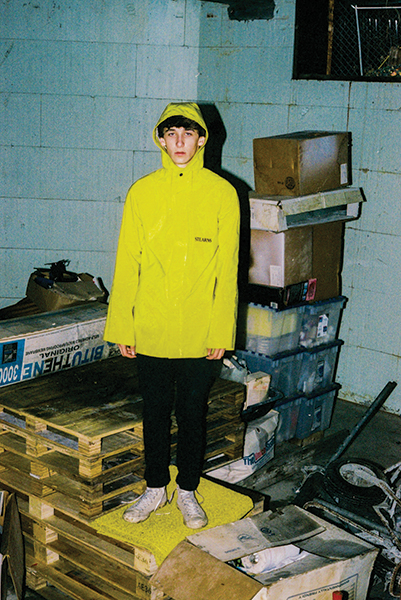The Analog Redux
Living analog in a digital world

Creativity flourishes with limitations, inspiration is a byproduct of constraints. Yet in today’s digital world, the usual restrictions that come with creating art seem to have melted away, replaced by DSLR cameras and autotune. The results are perfectly pristine, cold and distant, lacking the raw, unfiltered quality that works of the past possess. Analog devices, however, have these limitations – there are consequences for missing notes or a thumb blocking a lens. There is no editing, so the product is more representative of its circumstance, more genuine. Marketing experts and psychologists alike characterize teenagers of the late ‘90s and early 2000s – Generation Z – as authenticity-driven. As digital natives, members of Gen Z have had to wade through cesspools of internet misinformation, learning how to discern the trustworthy from the dubious. Social media in particular, with its ever-present plastic shine, has repeatedly led young people to the same conclusion: transparency, truth and authenticity are not to be found in the digital realm. With distrust for the virtual comes an embrace of the tangible, sparking the resurgence of analog devices such as film cameras and vinyl records. Stacks of Nirvana records stand tall at Urban Outfitters, #35mm litters Instagram captions — practices once considered obsolete have found their niche within the mainstream. Analog’s returning presence is undeniable and its causes are far more complex than solely a rebellion against modern times. While art itself tends to reveal the tones and truths of the present, the way in which the art is created and consumed is often overlooked. An inspection of these historic mediums and the revitalization of their usage leads us to the question: why analog?
Vinyl
As one major figure in the marked rise of analog, vinyl records may provide an answer. As recently as 2010 the United Record Press in Nashville, Tennessee was clearly losing the battle against iTunes and other digital streaming services and at an all time low for production numbers, pressing only a few thousand records a day with only 50 workers on staff. Fast-forward to 2014 when digital music is only expanding further and the same company has tripled in size of staff and pressing over 40,000 records per day; an all time high. This sharp growth defies all trends, all predictions, yet, it continues to grow.
The thrill of playing a record on a turntable is unfamiliar to most of the younger generations, but for a select few, vinyl is unparalleled as a listening method. Vinyl’s demographic is growing at a rate that is unrepresentative of the innovation-driven ethos of this day and age. From their inception, vinyl records dominated the music industry into the ‘80s and ‘90s. Following the record boom came dynasties of tapes and later, CDs. As tapes came and went and CDs grew obsolete, vinyl stuck around. But why is the most primitive and laborious medium still relevant to modern-day music consumption? The answer may lie in the tactile nature of records, and how that characteristic lends itself to the relationship between artist and listener.
“Records were tangible, they were colorful, they were big,” Paly music teacher Michael Najar said. “Anytime that you have to invest yourself in something it means that you grow closer in relationship to it.” The notion that records possess a tangibility not to be found in digital music has been sustained across generations. Although he didn’t grow up with vinyl, Paly senior Oscar Scherer shares Najar’s sentiment. “You could go into things like sound quality and all that, but that’s not really why I listen to records,” Scherer said. Instead, Scherer values the bond that records foster between artist and listener. “If you have a physical copy of music, you feel more connected to it.” Scherer said. “You can hold the album, you can hold the cover. It’s more interactive and I like that.”
Many professionals in the music industry believe that the sound fidelity of vinyl records is incomparable to other ways of listening; but to most, the difference in quality of sound is negligible. Bay Area professional guitarist, music producer and educator Kenny Corso is an avid record collector and vinyl enthusiast. “In a distracted world, analog seems pure,” Corso said. “A record is a break from that distraction, you can be more present with a record, it’s far more satisfying.” Apart from Corso’s emotional attachment to records, playing guitar professionally and producing music has exposed him to the subtle ways in which analog sound differs from digital. “Analog is an unbroken waveform; that is the musical definition of it,” Corso said. “Anything digital is a chopped up waveform even though the resolution is so high. I think we feel the continuity of the analog waveform even though it’s almost indistinguishable nowadays.” The pursuit of analog has been driving musicians like Corso for years now, many trying to emulate the pure sound that was so readily available at low cost just 10 or 15 years ago. The increasing relevance of vintage amplifiers, known as tube amps, is indicator of how guitarists are specifically are in pursuit of an analog sound. “It’s totally because of the fidelity, the warmth and the natural compression,” Corso said. “It’s more pleasing to the ear.”

Film
Quality photos are easy to take these days, and with the cameras on mobile phones shooting at the same resolution as entry level digital cameras, anyone can take a high quality picture at a relatively low cost. Earlier in the 2000s, digital photography was only just coming to fruition, and celebrated photography involved high prices and heavy gear. As the technological innovations that pertain to photography become increasingly accessible to the general public, those who seek unique photos that utilize all the capabilities of a camera must look back to the devices of the past. Before the entry of automatic digital cameras onto the photo marketplace, a skilled understanding of a cameras’ functions were a prerequisite for an excellent result. An eye for aesthetics is important, but if one does not understand how to apply the properties of light and speed to a camera’s’ settings, an eye has little importance in a dark, blurred photo. Instead of having a sensor, film cameras allow light to flood through the open shutter for a fraction of a second, causing a chemical reaction on photo film in the back of the camera. This leaves an impression on the film that is known as a negative until it is developed into an actual photo on paper. The knowledge-based and detail-oriented nature of film affords photographers the opportunity to be totally in control, manually.
Up until large scale production of digital cameras, film was the only option for photographers, but when digital cameras became readily available the effortlessness of perfectly exposed photos became standard. This is where the appeal of film lies: within the beauty of imperfection. Film photos are easy to pick out of a crowd nowadays – grainy, high contrast and in the case of color film, that very specific vintage color wash sought after by so many. Stanford University photography instructor Robert Dawson spoke to us to weigh in on the resurgence of film photography, from a professional’s point of view. Dawson was the mentee of Ansel Adams, arguably one of the most relevant photographers in the history of the camera, and has devoted his life to creating and sharing photos whilst educating others in the art. In his 40 years as a photographer, Dawson has been through numerous projects that expose social issues, especially in the natural world, through photography. Dawson has been shooting film his entire career, and only recently began incorporating digital cameras in his work when necessary. “It’s the beauty of it, and the process of developing a negative is a whole different animal in itself,” Dawson said. He described a significant upwards trend in his students interest in film recently. “It is interesting to see young people get in the darkroom for the first time,” Dawson said. “Doing something by hand is something we don’t see in our culture very much anymore, but we place more value on things done by hand.”
The resurgence of film photography is no stranger to Paly students, many of whom aspire to achieve the imperfect quality film possesses rather than to master the necessary skills. Student film photographer Sam Cook feels that flaws are considered as such, in fact they are desirable. “People who have just started often have many problems with their photos but they still enjoy the process and stop getting discouraged due to how beautiful film still is even when it is imperfect,” Cook said. “For example, even large imperfections like light leaks are considered cool by some.”

Psychology
In today’s modernizing world, an overwhelming sense of rationality has become prevalent in the technological and artistic industries. However, many continue to utilize analog devices and services of a bygone era that do not necessarily equate to modern technological standards. Choosing antiquated commodities over the convenience provided by current technology is not considered practical, so what is the psychological reasoning behind the choice of tangible, authentic objects over those that are created to provide perfection?
Today, most people are engrossed in the cultural and technological developments that occur constantly. While countless people are attracted to the promising future, a majority of society surveys the past to recognize the ways in which history has aided the world in the achievement of its current technological and cultural status. An increasing percentage of society has become consumed with regarding the past in a sentimental manner, particularly analog products and services of the previous era. The exploration of our past has transformed into a modest obsession with previous technology, styles and trends that used to appeal to those who had never seen anything like them before.
This is a realistic notion for Sabrina Martin, a student photographer who was drawn to film photography after discovering a box of her father’s old camera equipment from his high school and college days. “I was curious about the medium that I had so often seen my parents use when I was young, but then had so quickly left behind once digital photography became the norm,” Martin said. As demonstrated by advancement and Martin’s parents, technology develops, and the tastes of the general public are expected to do so as well. Some comply with the norm, while others are left wondering whether or not they agree with it.
Nostalgia as a driving force behind the revenge of analog is a thoroughly disputed concept. Although sentimentality is prominent within our culture, some believe the continued use of analog items is not necessarily suggested by the need to remember the past. This includes author David Sax of The Revenge of Analog, one of New York Times’ Top Books of 2016, who firmly explains that emotional connections have little influence. As one who experienced the shift from analog to the digital age, Sax clearly remembers the introduction of severe technological advancements. “PCs [were] being introduced into the home, the first internet, cell phones, broadband, smartphones, social networks, digital cameras, even CDs,” Sax said. “I was the last generation born into an analog environment.” In a conversation addressing his opinions regarding the revival of analog, Sax explains that this resurgence “isn’t a phenomenon of older folks going back to what they miss,” but it is merely the act of “judging the technology, analog and digital, for what it does for them, and choosing what works.” In comparison to the products offered throughout the analog era, modernized technology is generally regarded as the preferable option due to the convenience and perfection based advantages. Sax suggests that choosing analog over digital products is a choice that is not about rejecting current trends or a measurement of our sentimentality, but solely about convenience and comfort, and whether that is found in the products of an older era, or the the products of a more developed time.

However, the emotional aspect of one’s process of decision-making holds more power than is commonly understood. According to a Journal of Biomedical Informatics published by Elsevier and ScienceDirect, the emotional component of decision-making is commonly left out of scientific models and it not nearly regarded as highly as cognitive variables. A Classical Decision Theory exists to explain that decisions tend to deviate from a certain standard of rationality. While Sax believes that nostalgia does not influence decisions to choose analog products, emotional responses can scientifically impact our general decisions, which is demonstrated in a contrasting opinion. Dr. Jeffrey Sanchez-Burks, a Cultural Psychologist and Business School professor at the University of Michigan, examines the way in which our behavioral tendencies are rooted in and influenced by culture. Sanchez-Burks refers to the increase of those becoming curious about past trends or artistic styles as as intrigue in nostalgia. “On one hand, some people are going back to things they’ve loved, but then you’re also seeing a newer generation in a way, being reactionary, towards [the options] presented to them,” Sanchez-Burks said. According to Sanchez-Burks, different generations have been influenced by nostalgia when considering and using products of the analog era. The interest present within older generations is commonly explained via personal experience with analog objects, but as for younger generations there are numerous young adults who choose analog-era products over modern technology despite their wide-range of options. Sax and Sanchez-Burks both provide arguments suggesting reasoning behind the choice to use analog products, but younger generations remain outliers in their scope of research and experience. Lacking in personal experience, it is possible that many young adults are attempting to search for a form of authenticity in their lives, something that is not as common in today’s modern world.
This search for authenticity can be rooted in trends, a rejection of what is known or perhaps in the underlying significance of image. Those who were born into a modernized world have no personal experience with analog objects, yet continue to seek things that personify a sense of authenticity. Martin’s consistent use of various film cameras and demonstrated interest in the art of film photography clearly stems from more than nostalgia. “Younger generations are searching for a sense of authenticity and a specific image of individuality, which is why they choose analog over more modern technology,” Martin said. This sense of individuality is promoted by analog objects and the authenticity they provide, according to Sax. “[Younger generations] are the ones driving this, and I think it is because analog is a way of differentiating yourself as a consumer, creator, and individual,” Sax said. “Digital technology, by its very nature, is standardized. We all use the same software, the same social networks, and there’s little way to differentiate that. But in analog it’s all so personal. Even if we own the same records, the individual records are totally different and unique. And that allows you to dive in deep to craft your own identity in a way you simply can’t digitally.” It appears that the resurgence of analog has been pushed by a search for authentic identity, especially within teens that are pursuing new, fresh ideas and opportunities, but the procedure of consumption of consumer products has evolved.
The way in which people consume analog products has become considerably different from the consumer mannerisms of previous eras. “Shooting film has really become an upwards trend with the help of stores like Urban Outfitters and other mainstream media, so a lot of people are hopping onto the bandwagon,” Martin said. From a marketing standpoint, Sanchez-Burks agrees. “[Brands and companies] would not necessarily introduce something unless they had some evidence that there was some consumer demand,” Sanchez-Burks said, explaining that the resurgence of analog can be considered as just an additional trend.
Similar to the artificiality found in online media platforms, analog objects like film and vinyl also share this same sense of newness and modernity, primarily for younger generations. “This old technology is pretty much brand new to younger generations, which is another reason why people are so interested – they’ve never touched it before,” Martin said. Whether or not the decision to revert to the past stems from emotional responses correlating with nostalgia or the act of pursuing individuality and authenticity, analog requires exertion. In contrast to the convenience offered by modern technology, analog objects prove to be difficult, but the process is worth it to those who seek it. “A lot of the things that are analog require more labor, more care and more time, so it’s definitely not convenience that we are driven towards,” Sanchez-Burks said. Martin agrees, and compares the process of picking up developed film to Christmas morning. “The whole experience of waiting to get your developed film and prints back from the lab is so exciting,” Martin said. “When I get my film back, I’m pretty happy with the majority of the shots because I put that much more effort and thought into each one”.

Products of the analog era have clearly staked their place in artistic and technological industries for generations to come. When asked why analog things are appealing, Sax provides a straightforward, general answer that can apply to everyone who utilizes these products and services. “People are analog. It’s a simple answer but the truest one. We exist in the real world, and whatever happens on our screens is, at best, a really good simulation of that. Analog will always have that appeal because it is the ultimate example of that human experience,” Sax said.
It’s not uncommon to question technology’s progression, and to wonder if its benefits truly act as such. Digital cameras and advanced audio equipment have revolutionized the way we approach both performing and visual arts, and yet the ultra-perfect results that they produce may not be in accordance with everyone’s philosophy of what constitutes art. Whether for the sake of physical connection, individuality or nostalgia, creators and consumers fascination with analog seems to stem from an increasing desire for authenticity. We live in a hyper-edited world, in which all aspects of life seem to have the ability to be glossed over. In a culture that places such stress on contrived social media presence and perfection, it’s not surprising that we reach for mediums that highlight the humanity of our imperfections, the existence of our palpability. While digital mediums will continue to advance, it seems that analog will continue to assert its importance in artistic communities for generations. “It’s about taste, and that’s the beauty of today,” Najar said. “What do you want? Because there’s something for everyone.”








